LP60
Location: Lexton
Australian Soil Classification: Manganic, Subplastic, Red CHROMOSOL
General Landscape Description: Mid slope of a very gently undulating rise on an undulating volcanic plain.
Geology: Quaternary basalt.
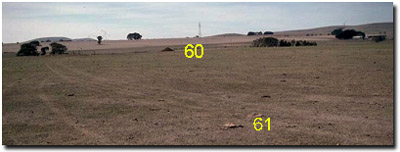 LP60 & LP61 Landscape |
Soil Profile Morphology:
| Surface Soil
| 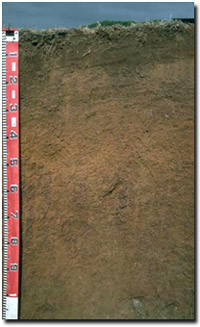 LP60 Profile | ||
| A11 | 0-15 cm | Dark reddish brown (5YR3/3); fine sandy clay loam; firm surface condition; moderate fine polyhedral structure; weak consistence moist; pH 5.2; abrupt change to:
| |
| A12 | 15-30 cm | Dark reddish brown (5YR3/4); clay loam (fine sandy); earthy fabric; moderate fine-medium polyhedral structure; contains many (40%) manganiferous nodules; firm consistence moist; pH 5.7; clear change to:
| |
| Subsoil
| |||
| B21 | 30-50 cm | Yellowish red (5YR4/6); light medium clay; (subplastic); moderate fine to medium polyhedral structure; very firm consistence dry; contains a common (20%) amount of manganese nodules and few (2%) ferro-manganiferous nodules; pH 6.1; clear and wavy change to:
| |
| B22 | 50-80 cm | Dark red (2.5YR3/6) with strong brown (7.5YR4/6) mottles; medium clay (subplastic); strong medium subangular blocky, parting to strong fine polyhedral structure (shiny-faced peds); very strong consistence dry; contains a common amount of ferro-manganiferous nodules (4 mm size range); pH 6.6; gradual change to:
| |
| B23 | 80-100 cm | Dark reddish brown (2.5YR3/4) with dark yellowish brown (10YR4/4) mottles; medium clay (subplastic); strong fine polyhedral, parting to strong medium polyhedral structure; strong consistence dry; pH 6.3; abrupt and wavy change to:
| |
| B31 | 100-130 cm | Brown (10YR5/3) with red (2.5YR4/8) and reddish yellow (7.5YR6/8) mottles heavy clay; moderate coarse prismatic structure (with shiny-faced peds); very strong consistence dry; pH 6.6; sharp change to:
| |
| C | 130 + cm | Weathered basalt. | |
Key Profile Features:
- Texture contrast between surface (A) and subsoil (B) horizons.
Soil Profile Characteristics:
pH | Salinity Rating | |||
Surface (A1 horizon) | Strongly Acid | Low | Non-Sodic | None |
Subsoil (B21 horizon) | Slightly Acid | Very Low | Non-Sodic | None |
Deeper subsoil (at 1 m) | Slightly Acid | Very Low | Non-Sodic | Strong |
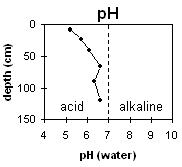 | 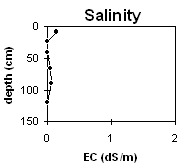 | 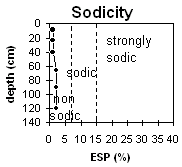 | 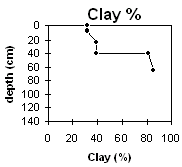 |
Horizon | Horizon Depth cm | pH (water) | pH CaCl2 | EC dS/m | Exchangeable Cations | Exchangeable Aluminium mg/kg | Field Capacity pF2.5 | Wilting Point pF4.2 | Coarse Sand (0.2-2.0mm) | Fine Sand (0.02-0.2mm) | Silt (0.002-0.02mm) | Clay (<0.002mm) | |||
Ca | Mg | K | Na | ||||||||||||
meq/100g | |||||||||||||||
A11 | 0-15 | 5.2 | 4.6 | 0.14 | 4.9 | 1.1 | 0.8 | 0.1 | 21 | 31.2 | 10.9 | 5 | 39 | 21 | 32 |
A12 | 15-30 | 5.7 | 4.7 | 0 | 4.8 | 1.9 | 0.6 | 0.1 | 23.2 | 13.4 | 16 | 24 | 15 | 39 | |
B21 | 30-50 | 6.1 | 5.3 | 0 | 5.7 | 6.1 | 0.4 | 0.2 | 42.8 | 27.2 | 3 | 8 | 7 | 81 | |
B22 | 50-80 | 6.6 | 6 | 0.05 | 4.2 | 8.2 | 0.3 | 0.2 | 41 | 32.7 | 2 | 6 | 7 | 85 | |
B23 | 80-100 | 6.3 | 5.9 | 0.07 | 3.7 | 0.4 | 0.3 | 0.3 | |||||||
B31 | 100-130 | 6.6 | 5.5 | 0 | 4.8 | 14 | 0.2 | 0.5 | |||||||
Management Considerations:
Whole Profile
- Plant available water capacity (PAWC) is relatively high (estimated at 160 mm). This is based on available laboratory data and assumes an estimated effective rooting depth of 100 cm. This soil is therefore least likely to restrict pasture growth into a dry spring and summer and will offer greater potential for cropping than for the other sites examined.
- The surface soil is strongly acid which indicates that aluminium and manganese toxicity may occur. However, the exchangeable aluminium level (measured in the laboratory) for this site is not high and is unlikely to result in restricted plant growth. This measurement has been taken from only one point in the paddock so a pH/aluminium test sampled at the paddock level may be appropriate to determine whether lime is needed to raise the pH.
- The surface soil is moderately structured and the aggregates are water-stable. As a result, infiltration of water is likely to be relatively high.
- Organic carbon and total nitrogen levels are reasonable for the surface horizon. Organic carbon is important for maintaining surface soil structure and can be improved by practices such as pasture rotation and minimum tillage if cropping occurs. Maintaining organic matter levels is important for surface soils with relatively high levels of fine sand and silt, as it assists aggregate stabilisation.
- The upper B21 horizons are non-sodic and well structured which indicates that root and water movement are not likely to be significantly restricted. Profile drainage should therefore be adequate within the top metre of this soil profile.
- At one metre depth, the subsoil structure becomes more coarsely structured and, although non-sodic, it disperses strongly (probably due to low calcium-magnesium ratio) which will result in restricted root and water movement at depth.
- Mainly used for grazing but potatoes are grown on similar soils in the area.


